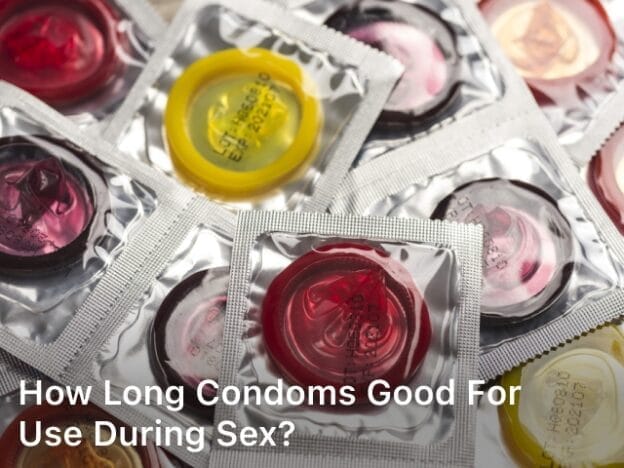nutrivitalhealth.com. How Long Condoms Good for Use During Sex? – Discover the essential facts about how long condoms remain effective during sex. Learn about expiry dates, proper storage, and crucial insights for a safe and satisfying sexual experience. Find answers to your questions on condom durability. In today’s world, sexual health awareness is more important than ever. One of the key components of safe sexual practices is the proper use of condoms. Condoms act as a barrier method of contraception, protecting against unwanted pregnancies and sexually transmitted infections (STIs). But have you ever wondered, “How long are condoms good for use during sex?” This comprehensive guide will answer this question and provide you with essential insights into the shelf life, storage, and usage of condoms. Understanding Condom Expiry Dates The Importance of Expiry Dates When it comes to using condoms, paying attention to the expiry date is crucial. An expiry date is the manufacturer’s guarantee that the condom will be effective up to that point. Using condoms past their expiry date can lead to reduced effectiveness, potentially putting you at risk. Where to Find the Expiry Date The expiry date is typically printed on the packaging of the condom. It is essential to check this date before use. Condoms with a close-to-expiry date should be used soon, while those well within their expiration period can be stored for later use. What Happens After Expiry Condoms are made of latex or polyurethane, and over time, these materials can degrade. Once a condom has passed its expiry date, it becomes more brittle and less flexible. This makes it more likely to tear or fail during use, increasing the risk of unwanted pregnancy or STIs. Factors Affecting Condom Shelf Life 1. Storage Conditions Proper storage is crucial to extend the shelf life of condoms. Condoms should be kept in a cool, dry place away from direct sunlight and extreme temperatures. Storing them in a wallet or glove compartment, where they may be subjected to heat and pressure, can lead to premature degradation. 2. Quality of the Condom The quality of condoms can vary between brands and types. It’s essential to choose reputable brands and check for any quality certifications when purchasing condoms. High-quality condoms tend to have a longer shelf life and are more reliable during use. 3. Material of the Condom Latex and polyurethane condoms have different characteristics. Latex condoms are the most common and have a shelf life of around five years when stored correctly. Polyurethane condoms, on the other hand, may have a shorter shelf life, so it’s crucial to check the packaging for the manufacturer’s recommendations. Proper Storage Techniques 1. Keep in Original Packaging Condoms are individually packaged for a reason. It’s best to keep them in their original packaging until you’re ready to use them. This protects them from exposure to air and potential damage. 2. Avoid Extreme Temperatures As mentioned earlier, extreme temperatures can damage condoms. Avoid storing them in places where they may be exposed to excessive heat or cold, such as your car’s glove compartment or a sunny windowsill. 3. Regularly Check Expiry Dates Make it a habit to check the expiry dates of your condoms periodically. This ensures that you don’t accidentally use an expired condom in the heat of the moment. How Long Condoms Good for Use During Sex? The answer to “How long are condoms good for use during sex?” varies depending on the factors mentioned above. On average, condoms can be considered reliable up to five years from the date of manufacture if stored correctly. However, it’s always best to check the specific expiry date on the packaging. Remember that using a condom beyond its expiry date or one that has been stored improperly increases the risk of breakage or failure during sex. To ensure your safety, it’s wise to use condoms within their recommended period. How Condoms Work Condoms work by creating a physical barrier between the genitals of sexual partners, which serves two primary purposes: Pregnancy Prevention For Male Condoms A male condom is a sheath made of latex or polyurethane that is rolled onto the erect penis before sexual intercourse. It collects and contains the semen ejaculated during intercourse, preventing it from coming into direct contact with the partner’s vagina. This barrier prevents sperm from reaching and fertilizing an egg, thus reducing the risk of pregnancy. For Female Condoms A female condom is a pouch-like device made of polyurethane or nitrile that is inserted into the vagina before intercourse. It lines the vaginal walls and covers the cervix, providing a barrier to block sperm from entering the uterus and reaching an egg. Protection against Sexually Transmitted Infections (STIs) Condoms, both male and female, also serve as a barrier against the exchange of bodily fluids, including semen and vaginal secretions. This barrier helps reduce the risk of transmitting or contracting sexually transmitted infections (STIs), such as HIV, chlamydia, gonorrhea, and syphilis. While condoms provide significant protection, they do not offer 100% protection against all STIs, as some infections can be transmitted through skin-to-skin contact in areas not covered by the condom. How Long are Condoms Usually Good For? Condoms typically have an expiration date printed on the packaging, which is usually a few years from the date of manufacture. The exact length of time condoms are good for can vary depending on the manufacturer and the materials used, but it’s generally safe to assume that condoms remain effective for about 3 to 5 years from the date of manufacture. It’s essential to check the expiration date on the condom packaging before use. Using condoms that have passed their expiration date can reduce their effectiveness and increase the risk of breakage or failure. Expired condoms may become more brittle and less reliable as a barrier against pregnancy and sexually transmitted infections. To ensure that you are using condoms that are within their usable timeframe, regularly check the expiration date, and avoid using any that have expired. Proper storage is


